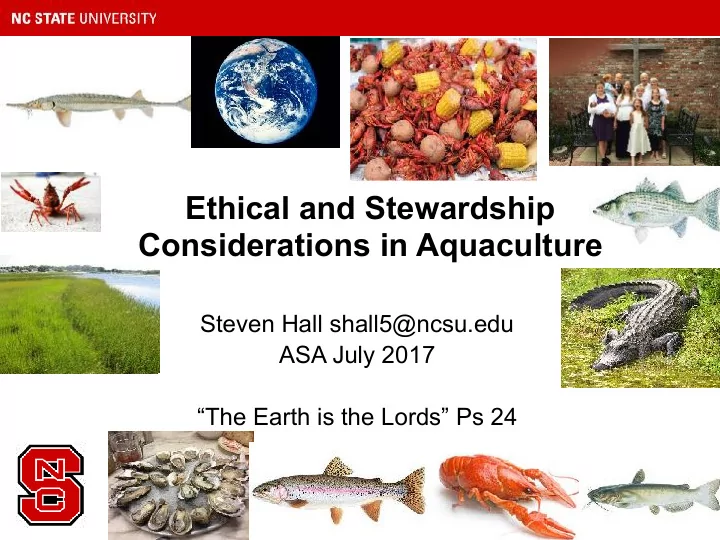

Ethical and Stewardship Considerations in Aquaculture Steven Hall shall5@ncsu.edu ASA July 2017 “The Earth is the Lords” Ps 24
What is Aquaculture? (vs. Terraculture) Culture of Animals, Plants, Bacteria… in/with Water Examples: Finfish (Fresh or Marine); Reptiles, Molluscs, Crustaceans; Microalgae; Macroalgae (seaweed); Plants (wetlands…); Bacteria…
Who/where grows it now? (China: 50+%) (US: $1B <1%) Trade: US Imports ~$20B Who needs it (now/future)?
Ethical/Stewardship Issues in Aquaculture Rich vs. Poor (tilapia vs. carnivorous) Creation Care (Environmental Ethics – water) Economics (energy/resources) Human/Animal Health Genetic Issues (Bio-resources) Gen 1:26 … dominion… over the fish… Gen. 2:15 … shmar and abad… Matt. 25:40 ...for the least of these… Rev 22: … river of water of life… (city/fruitful/heal/th)
Rich vs. Poor Aquaculture can have FCRs of 1-2 (0.3-5) Compare to Chicken 2-3; Pork 3-4; Beef 6-20 Rich desire “high trophic level” e.g. salmonids (carnivorous); sturgeon/caviar Feed World: Low trophic level Efficient production Very cheap: tilapia, catfish, carp… …to the least of these…
Creation Care (Environmental Ethics – water) Recirculating Aquaculture Systems (RAS) Recycle water: efficient water use (90-100%) High capital costs Energy costs: e.g. pumps Energy efficient: e.g. LHO Multi-raceways (18x = 94% recirc) Possibly improved environmental impacts … shmar and abad… Gen 2:15 Efficient production -> Natural stocks can recover
Economics Rich vs. Poor (tilapia vs. carnivorous) Efficiency: Water; Energy; P; N; C Externalities (accounted?) High Protein Food High Value Products (tilapia/skin… health) Ecological Services (e.g. P/N/C efficiency/conversion/ sequestration) … least of these… (use talents given you)
Key Market/Environment/Technology Issues in Aquaculture Lower Trophic Levels More Plant Based Feeds Waste Management Disease Management Local/Global Advantages Stewardship Social Issues
Human/Animal Health IACUC Protocols (Animal Care) Better control in RAS/Ponds Safer food (less metals, etc.) “Natural?” Ethical Treatment of Animals
Genetic Modification in Fish AquAdvantage Salmon (J. Buchanan et al.) Atlantic/Chinook/Pout 11x growth rate (y1) “Frankenfish?” Possible competition (less efficient swimmer) Triploid females (sterile 98.9%) FDA: “highly unlikely… environment” “as safe as… conventional” (US 2010-15; Canada 2016)
NC Species/Work Trophic Levels: Lower: Algae, Macroalgae, Oysters, Tilapia Higher: Salmonids; Bass (Sturgeon) 14
Lower Trophic Levels More Plant Based Feeds Waste Management
Marine Aquaculture Research Center (MARC) • Advantages – Unique access to coast/salinity capabilities – Custom built; independent systems – Under our control – Good backup power/water – Neighbors with Marshallberg Farm (sturgeon) • Disadvantages – Rural/access to visitors (3h Raleigh; 30min Morehead) – No dorms/minimal offices/meeting rooms • Unique Features – Solar/Wind; Marine; Waste Treatment; 7 species
Marine Aquaculture Research Center (MARC)
Summary Fish efficient at growing: FCR can be <1 Work to be done: Trophic; Resources; Efficiency; Economics; Social; International Engineering for Production Engineering for Sustainability Engineering for Growth, Ethically Grow the successes; invent new winners shall5@ncsu.edu
Hungry to Grow
Research/Discovery (MARC/FishBarn) Collaborators (LaPaz) Water Quality: Biofiltration, Constr. Wetlands, Resource Use Q1: How to approach zero discharge (animal/plant/algae)? Q2: How to add/extract value from “waste”? Q3: How to produce aquaculture and protect coast/water? Larval/Reproductive Techniques: Sturgeon Q1: How to use ultrasound to ID egg quality (“smart” caviar)? Q2: How to allow/enhance reproduction for long-lived finfish (Sturgeon, Black Drum, Porgy/Bream…)? Q3: Larval diets for large finfish? (w Peter Ferket, Harry…) Harvest/Postharvest (Food safety) Q1: How to produce safer foods? (w D. Green) Q2: How to market/engineering/packaging? Q3: Culture microorganisms (bioproc/bioreactors)? (w Ben Reading et al.; Jon Bell)
Research Goals PhD: D. Smith, M. Greensword, S. Oladi (LSU) NCSU RA: Ryan Kelly, Marine Aquaculture Rsch Ctr (MARC) (Hybrid Striped Bass, Sturgeon, Marine Species, Oysters) PhD: Melody Thomas (Water Quality/Constr Wetlands and Gators); Matt Campbell (Coastal Aqua/Protection) MS: Alex Geddie (Sust. Development/Sust Aqua) Senior Design: Kelly, Alexi, Ben, Andrew, Natalie Aquaculture and Ecosystem Services: CO2/N sequestration Grant$ : Multistate (funded/approved): Vehicles/Water SBIR: NSF/NOAA (Coastal bioeng. tech.) SeaGrant (Water/Aquaculture; Process…); NIFA: Macroalgae w Cheng, Dubbs et al. Pubs (16-17): Living Shorelines Chapter; Vehicles pubs: plant harvest/water quality; oyster pubs (Melody…); Coastal (Matt…); Alligators (C. Malveaux); Sturgeon, finfish upcoming
Conserve AND Grow Long-Line and Boom Systems; Bioengineered Oyster Reefs 22
Research Goals (Sustainably) Grow NC Industry � 2016 � 2020 � 2025 “Large” value: ($50M � $100M+) Trout � $9M � $10M � 15M ($21-50M+, WQ) HSB � $11M � $15M+ ($50M, Market/Growth) Catfish � $5M � ($17-20M+, Proc; Value) Tilapia � $3M, Extension/Expansion “Special/small” value: ($1M � $90M?) Oysters $350K � $1M+ � $5M+ ($20M) Sturgeon** $800K � $1M+ � $5M+ ($50M) Crayfish � $40K � $200K � $1M+ ($10M) Alligators � $0 � something � $1M+ ($10M) Plants/Algae/Macroalgae $small � $1M+ file:///C:/Users/shall5.SHALL5-LAPTOP/Desktop/2015aquaNCADCUpdate.pdf
Extension Learn Industry, Serve Industry Grow Industry Currently ~$58M Goal: >$100M by early 2020s Enhance Sustainability/Responsibility BOTH/AND Production AND Eco/Env “Have your fish and eat them too”
Teaching Students Classes Online Web Research Papers Undergraduate Research Extension Pubs Extension Research 34 25.5 Life-long learners Graduate Students 17 Field Days/Demos Univ/Govt/Industry 8.5 MARC/FishBarn Grants/Contracts 0 1 26 51 76 101 126 151 176 201 226 251 276 301 326 351 376 401 426 Aquaponic$ Club Research Pubs/Books Minutes Youth (SOS) Online Grow Industry Web Online Grow Industry Web Sustainable/Env
Summary Work to be done Engineering for Production Engineering for Sustainability Engineering for Growth by 2020’s Grow the successes; invent new winners
Hungry to Grow
Recommend
More recommend